Evidence of Supplementation Usage in the Elders
VerifiedAdded on 2023/04/06
|6
|1274
|74
AI Summary
This article discusses the evidence of supplementation usage in the elders and the associated health problems. It explores the importance of meeting the dietary needs of older people for their health and quality of life.
Contribute Materials
Your contribution can guide someone’s learning journey. Share your
documents today.
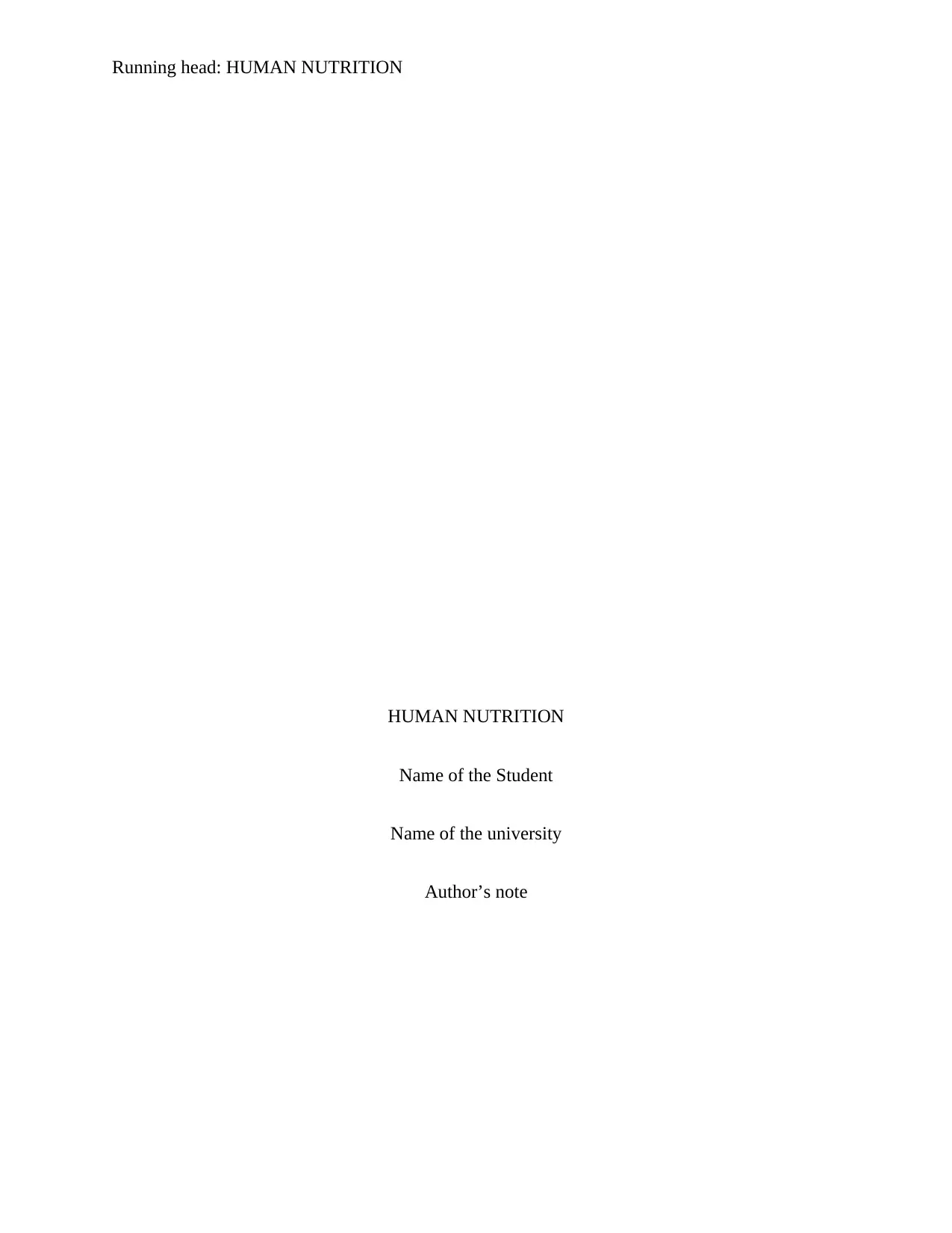
Running head: HUMAN NUTRITION
HUMAN NUTRITION
Name of the Student
Name of the university
Author’s note
HUMAN NUTRITION
Name of the Student
Name of the university
Author’s note
Secure Best Marks with AI Grader
Need help grading? Try our AI Grader for instant feedback on your assignments.

1HUMAN NUTRITION
Evidence of supplementation usage in the elders
Malnutrition and age related health problems associated with diet
Introduction
The older population is increasing worldwide and in many countries the older people will
outnumber the younger population in the near future. Meeting the diets and the needs of the older
people us therefore necessary for the maintenance of the health, functional independence and the
quality of life (Leslie and Hankey 2015). Malnutrition, encompassing both under and over
nutrition increases the risk of health in the older population. This section will discuss about the
malnutrition and age related health problem associated with the eating habits.
Discussion
A literature review has been conducted by selecting relevant from electronic databases
like CINAHL and PubMed. The papers has been chosen within the publication years 2012-2019
and relevant papers related to adult nutrition and diseases has been selected by using appropriate
keywords. The Australian Guide for Healthy Eating, has also been referred to for evaluating the
dietary requirement of the older adults.
Older person are vulnerable to nutrition and attempts to provide them with proper
nutrition might encounter several practical problems. This is due to the fact that nutritional
requirements of the older person are not well defined. Both the basal metabolic rate and the lean
body mass decline with age and the energy requirement per kilogram of the body weight is also
reduced. Dietary fat has been associated with colon cancer, prostate cancer and pancreatic
Evidence of supplementation usage in the elders
Malnutrition and age related health problems associated with diet
Introduction
The older population is increasing worldwide and in many countries the older people will
outnumber the younger population in the near future. Meeting the diets and the needs of the older
people us therefore necessary for the maintenance of the health, functional independence and the
quality of life (Leslie and Hankey 2015). Malnutrition, encompassing both under and over
nutrition increases the risk of health in the older population. This section will discuss about the
malnutrition and age related health problem associated with the eating habits.
Discussion
A literature review has been conducted by selecting relevant from electronic databases
like CINAHL and PubMed. The papers has been chosen within the publication years 2012-2019
and relevant papers related to adult nutrition and diseases has been selected by using appropriate
keywords. The Australian Guide for Healthy Eating, has also been referred to for evaluating the
dietary requirement of the older adults.
Older person are vulnerable to nutrition and attempts to provide them with proper
nutrition might encounter several practical problems. This is due to the fact that nutritional
requirements of the older person are not well defined. Both the basal metabolic rate and the lean
body mass decline with age and the energy requirement per kilogram of the body weight is also
reduced. Dietary fat has been associated with colon cancer, prostate cancer and pancreatic
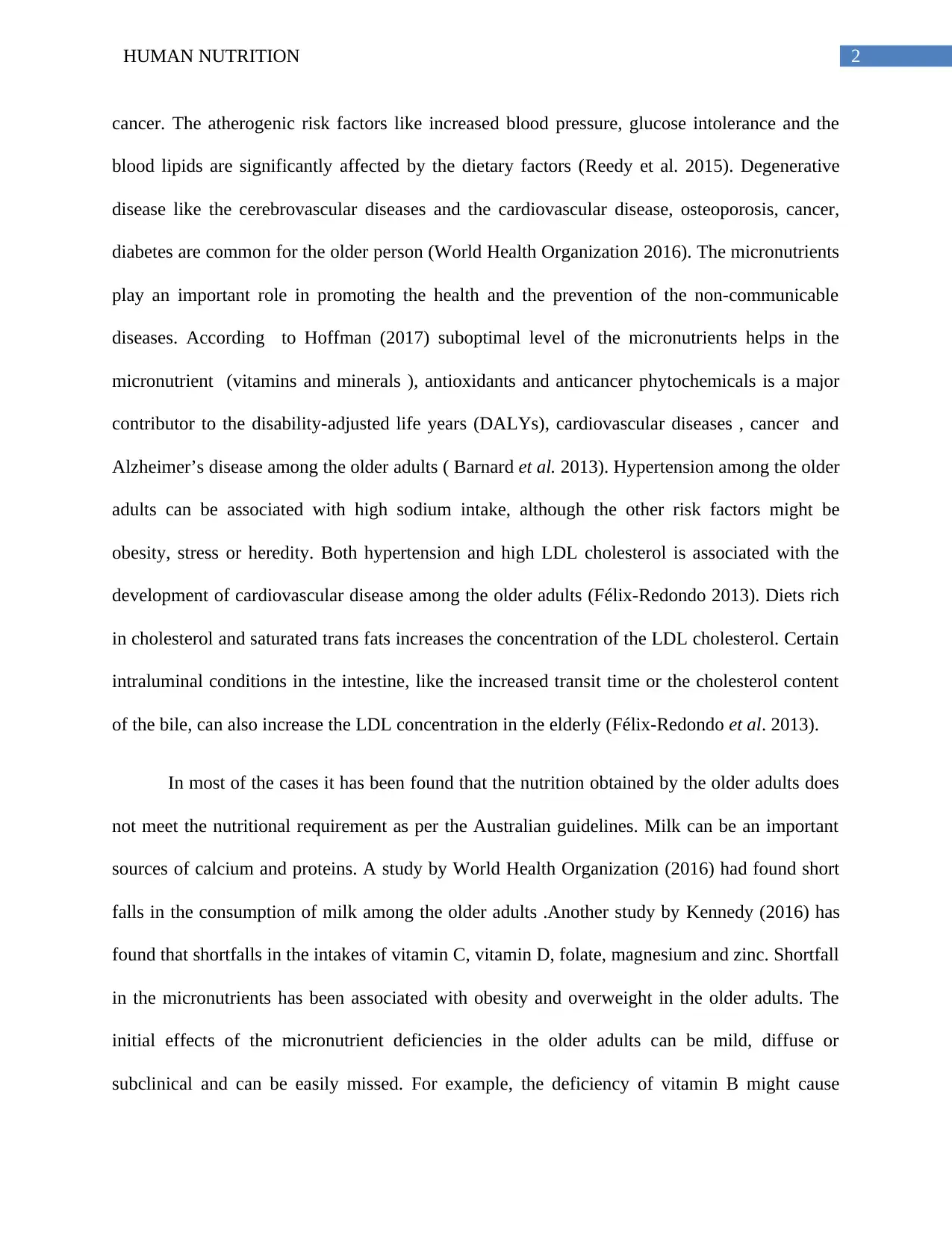
2HUMAN NUTRITION
cancer. The atherogenic risk factors like increased blood pressure, glucose intolerance and the
blood lipids are significantly affected by the dietary factors (Reedy et al. 2015). Degenerative
disease like the cerebrovascular diseases and the cardiovascular disease, osteoporosis, cancer,
diabetes are common for the older person (World Health Organization 2016). The micronutrients
play an important role in promoting the health and the prevention of the non-communicable
diseases. According to Hoffman (2017) suboptimal level of the micronutrients helps in the
micronutrient (vitamins and minerals ), antioxidants and anticancer phytochemicals is a major
contributor to the disability-adjusted life years (DALYs), cardiovascular diseases , cancer and
Alzheimer’s disease among the older adults ( Barnard et al. 2013). Hypertension among the older
adults can be associated with high sodium intake, although the other risk factors might be
obesity, stress or heredity. Both hypertension and high LDL cholesterol is associated with the
development of cardiovascular disease among the older adults (Félix-Redondo 2013). Diets rich
in cholesterol and saturated trans fats increases the concentration of the LDL cholesterol. Certain
intraluminal conditions in the intestine, like the increased transit time or the cholesterol content
of the bile, can also increase the LDL concentration in the elderly (Félix-Redondo et al. 2013).
In most of the cases it has been found that the nutrition obtained by the older adults does
not meet the nutritional requirement as per the Australian guidelines. Milk can be an important
sources of calcium and proteins. A study by World Health Organization (2016) had found short
falls in the consumption of milk among the older adults .Another study by Kennedy (2016) has
found that shortfalls in the intakes of vitamin C, vitamin D, folate, magnesium and zinc. Shortfall
in the micronutrients has been associated with obesity and overweight in the older adults. The
initial effects of the micronutrient deficiencies in the older adults can be mild, diffuse or
subclinical and can be easily missed. For example, the deficiency of vitamin B might cause
cancer. The atherogenic risk factors like increased blood pressure, glucose intolerance and the
blood lipids are significantly affected by the dietary factors (Reedy et al. 2015). Degenerative
disease like the cerebrovascular diseases and the cardiovascular disease, osteoporosis, cancer,
diabetes are common for the older person (World Health Organization 2016). The micronutrients
play an important role in promoting the health and the prevention of the non-communicable
diseases. According to Hoffman (2017) suboptimal level of the micronutrients helps in the
micronutrient (vitamins and minerals ), antioxidants and anticancer phytochemicals is a major
contributor to the disability-adjusted life years (DALYs), cardiovascular diseases , cancer and
Alzheimer’s disease among the older adults ( Barnard et al. 2013). Hypertension among the older
adults can be associated with high sodium intake, although the other risk factors might be
obesity, stress or heredity. Both hypertension and high LDL cholesterol is associated with the
development of cardiovascular disease among the older adults (Félix-Redondo 2013). Diets rich
in cholesterol and saturated trans fats increases the concentration of the LDL cholesterol. Certain
intraluminal conditions in the intestine, like the increased transit time or the cholesterol content
of the bile, can also increase the LDL concentration in the elderly (Félix-Redondo et al. 2013).
In most of the cases it has been found that the nutrition obtained by the older adults does
not meet the nutritional requirement as per the Australian guidelines. Milk can be an important
sources of calcium and proteins. A study by World Health Organization (2016) had found short
falls in the consumption of milk among the older adults .Another study by Kennedy (2016) has
found that shortfalls in the intakes of vitamin C, vitamin D, folate, magnesium and zinc. Shortfall
in the micronutrients has been associated with obesity and overweight in the older adults. The
initial effects of the micronutrient deficiencies in the older adults can be mild, diffuse or
subclinical and can be easily missed. For example, the deficiency of vitamin B might cause
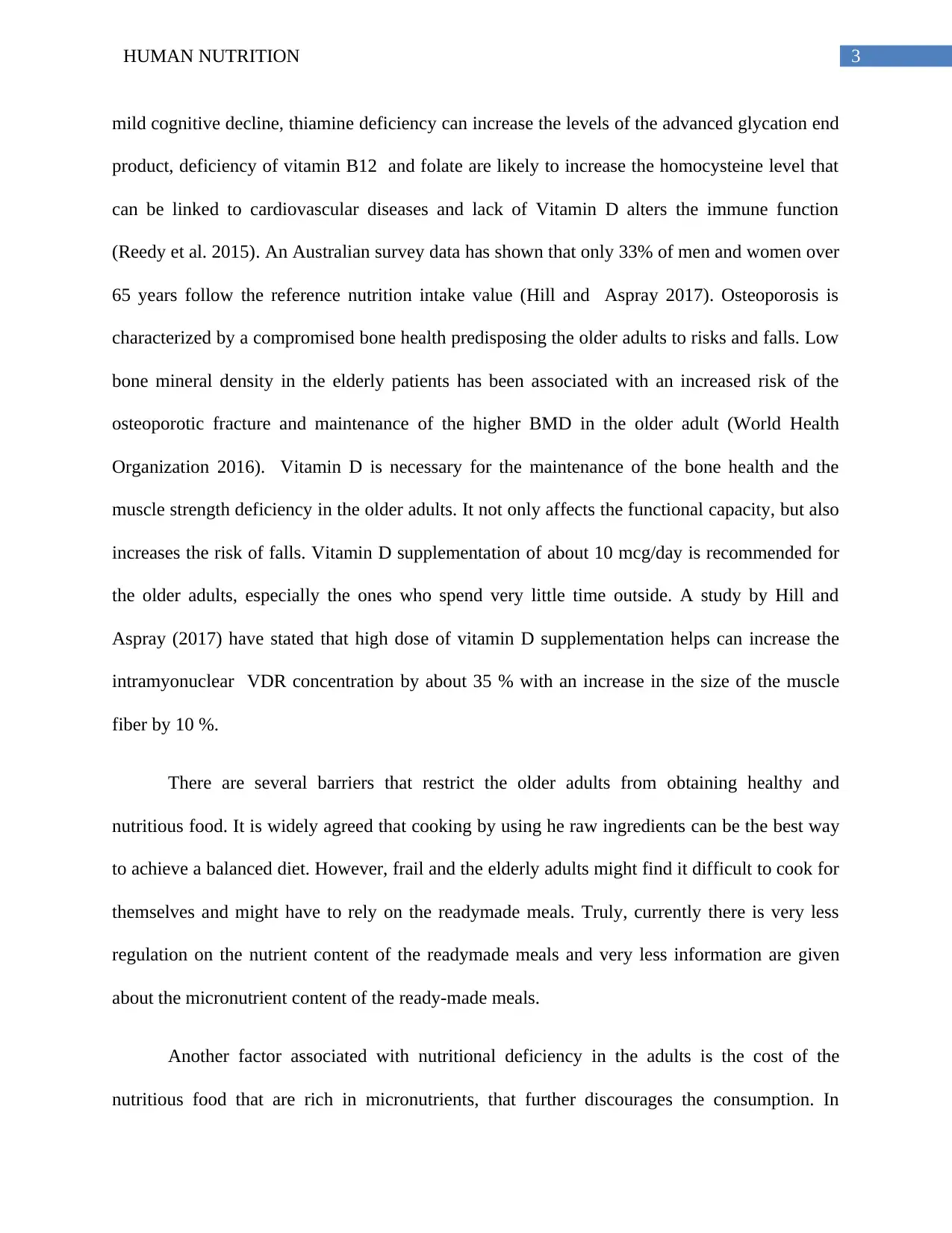
3HUMAN NUTRITION
mild cognitive decline, thiamine deficiency can increase the levels of the advanced glycation end
product, deficiency of vitamin B12 and folate are likely to increase the homocysteine level that
can be linked to cardiovascular diseases and lack of Vitamin D alters the immune function
(Reedy et al. 2015). An Australian survey data has shown that only 33% of men and women over
65 years follow the reference nutrition intake value (Hill and Aspray 2017). Osteoporosis is
characterized by a compromised bone health predisposing the older adults to risks and falls. Low
bone mineral density in the elderly patients has been associated with an increased risk of the
osteoporotic fracture and maintenance of the higher BMD in the older adult (World Health
Organization 2016). Vitamin D is necessary for the maintenance of the bone health and the
muscle strength deficiency in the older adults. It not only affects the functional capacity, but also
increases the risk of falls. Vitamin D supplementation of about 10 mcg/day is recommended for
the older adults, especially the ones who spend very little time outside. A study by Hill and
Aspray (2017) have stated that high dose of vitamin D supplementation helps can increase the
intramyonuclear VDR concentration by about 35 % with an increase in the size of the muscle
fiber by 10 %.
There are several barriers that restrict the older adults from obtaining healthy and
nutritious food. It is widely agreed that cooking by using he raw ingredients can be the best way
to achieve a balanced diet. However, frail and the elderly adults might find it difficult to cook for
themselves and might have to rely on the readymade meals. Truly, currently there is very less
regulation on the nutrient content of the readymade meals and very less information are given
about the micronutrient content of the ready-made meals.
Another factor associated with nutritional deficiency in the adults is the cost of the
nutritious food that are rich in micronutrients, that further discourages the consumption. In
mild cognitive decline, thiamine deficiency can increase the levels of the advanced glycation end
product, deficiency of vitamin B12 and folate are likely to increase the homocysteine level that
can be linked to cardiovascular diseases and lack of Vitamin D alters the immune function
(Reedy et al. 2015). An Australian survey data has shown that only 33% of men and women over
65 years follow the reference nutrition intake value (Hill and Aspray 2017). Osteoporosis is
characterized by a compromised bone health predisposing the older adults to risks and falls. Low
bone mineral density in the elderly patients has been associated with an increased risk of the
osteoporotic fracture and maintenance of the higher BMD in the older adult (World Health
Organization 2016). Vitamin D is necessary for the maintenance of the bone health and the
muscle strength deficiency in the older adults. It not only affects the functional capacity, but also
increases the risk of falls. Vitamin D supplementation of about 10 mcg/day is recommended for
the older adults, especially the ones who spend very little time outside. A study by Hill and
Aspray (2017) have stated that high dose of vitamin D supplementation helps can increase the
intramyonuclear VDR concentration by about 35 % with an increase in the size of the muscle
fiber by 10 %.
There are several barriers that restrict the older adults from obtaining healthy and
nutritious food. It is widely agreed that cooking by using he raw ingredients can be the best way
to achieve a balanced diet. However, frail and the elderly adults might find it difficult to cook for
themselves and might have to rely on the readymade meals. Truly, currently there is very less
regulation on the nutrient content of the readymade meals and very less information are given
about the micronutrient content of the ready-made meals.
Another factor associated with nutritional deficiency in the adults is the cost of the
nutritious food that are rich in micronutrients, that further discourages the consumption. In
Secure Best Marks with AI Grader
Need help grading? Try our AI Grader for instant feedback on your assignments.
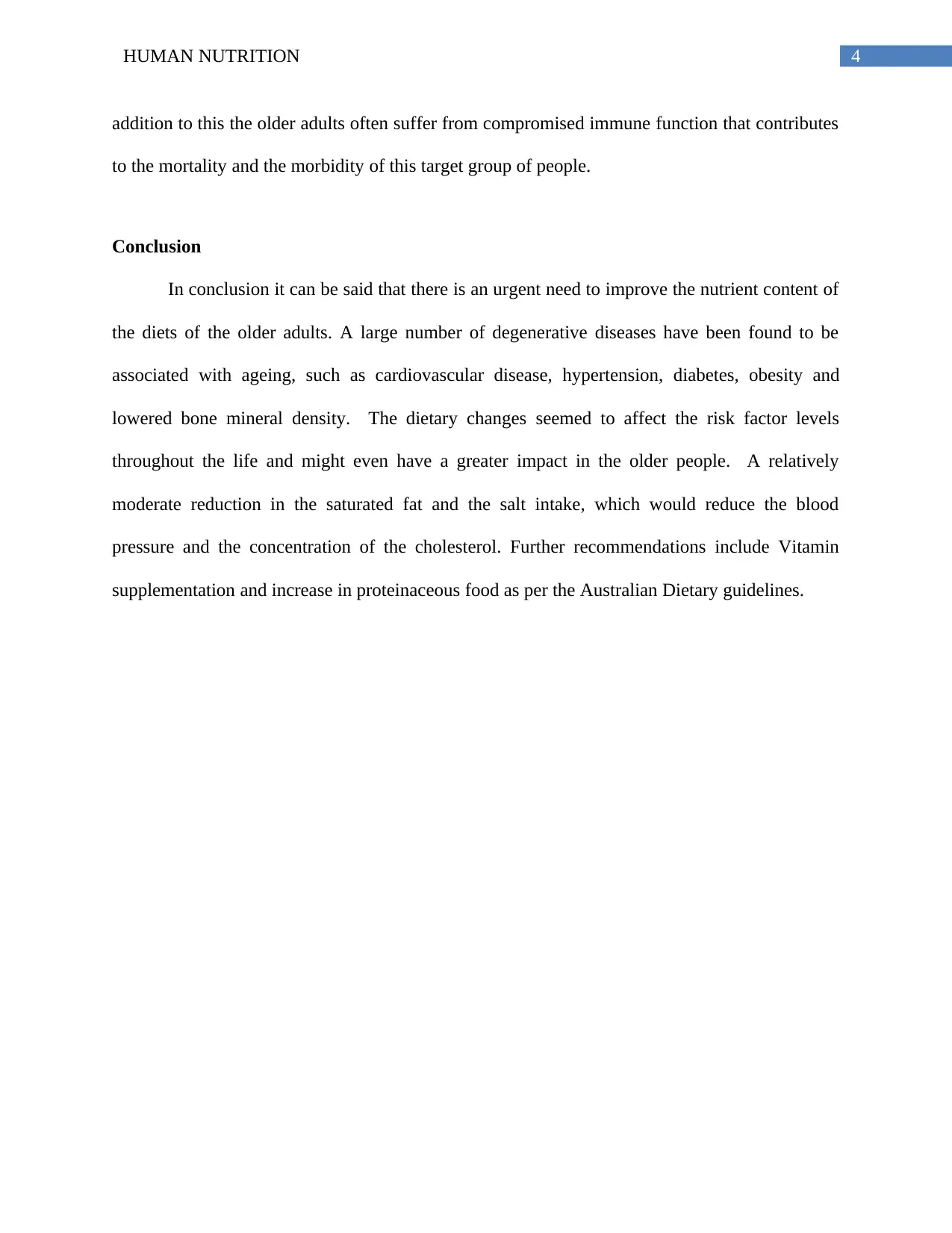
4HUMAN NUTRITION
addition to this the older adults often suffer from compromised immune function that contributes
to the mortality and the morbidity of this target group of people.
Conclusion
In conclusion it can be said that there is an urgent need to improve the nutrient content of
the diets of the older adults. A large number of degenerative diseases have been found to be
associated with ageing, such as cardiovascular disease, hypertension, diabetes, obesity and
lowered bone mineral density. The dietary changes seemed to affect the risk factor levels
throughout the life and might even have a greater impact in the older people. A relatively
moderate reduction in the saturated fat and the salt intake, which would reduce the blood
pressure and the concentration of the cholesterol. Further recommendations include Vitamin
supplementation and increase in proteinaceous food as per the Australian Dietary guidelines.
addition to this the older adults often suffer from compromised immune function that contributes
to the mortality and the morbidity of this target group of people.
Conclusion
In conclusion it can be said that there is an urgent need to improve the nutrient content of
the diets of the older adults. A large number of degenerative diseases have been found to be
associated with ageing, such as cardiovascular disease, hypertension, diabetes, obesity and
lowered bone mineral density. The dietary changes seemed to affect the risk factor levels
throughout the life and might even have a greater impact in the older people. A relatively
moderate reduction in the saturated fat and the salt intake, which would reduce the blood
pressure and the concentration of the cholesterol. Further recommendations include Vitamin
supplementation and increase in proteinaceous food as per the Australian Dietary guidelines.
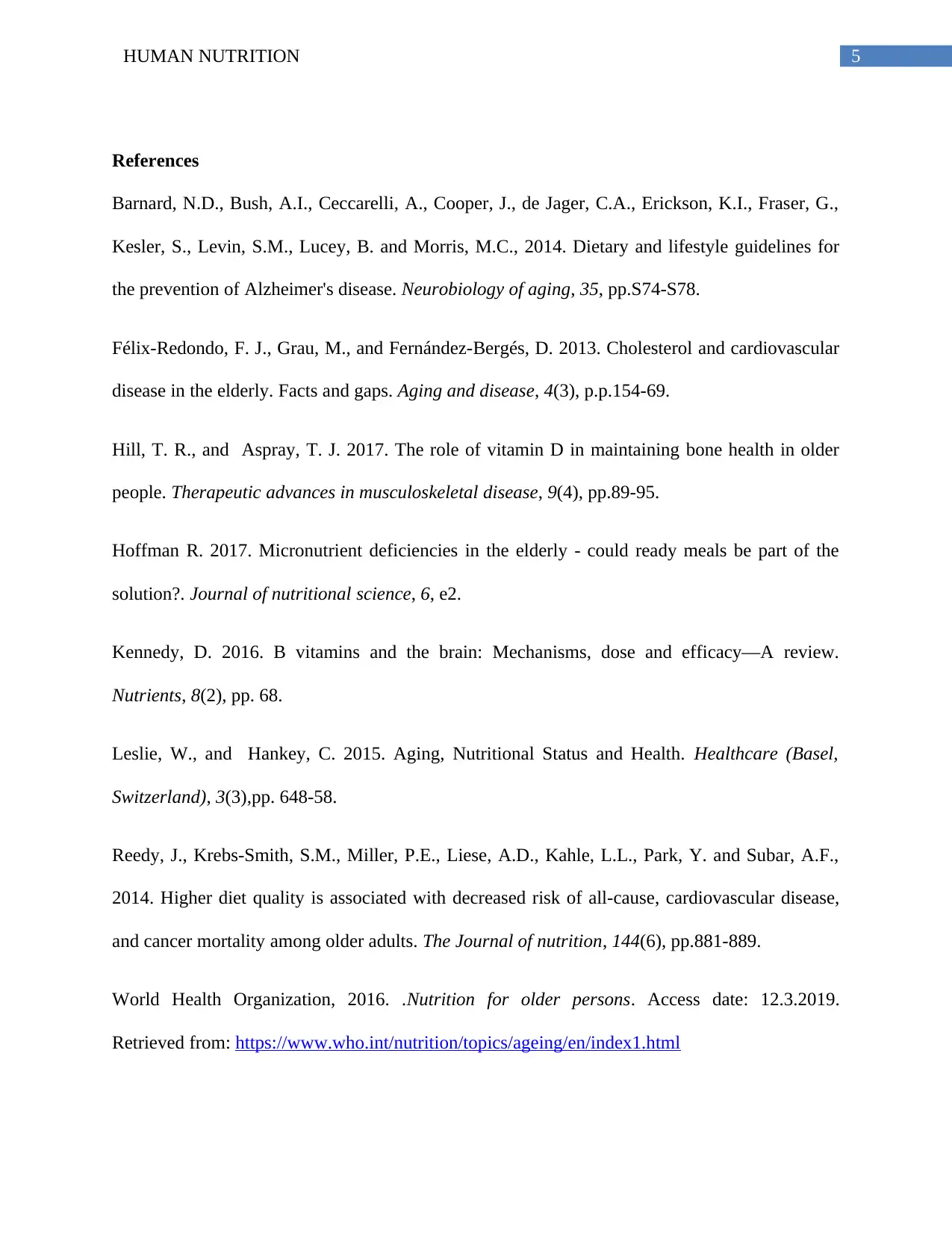
5HUMAN NUTRITION
References
Barnard, N.D., Bush, A.I., Ceccarelli, A., Cooper, J., de Jager, C.A., Erickson, K.I., Fraser, G.,
Kesler, S., Levin, S.M., Lucey, B. and Morris, M.C., 2014. Dietary and lifestyle guidelines for
the prevention of Alzheimer's disease. Neurobiology of aging, 35, pp.S74-S78.
Félix-Redondo, F. J., Grau, M., and Fernández-Bergés, D. 2013. Cholesterol and cardiovascular
disease in the elderly. Facts and gaps. Aging and disease, 4(3), p.p.154-69.
Hill, T. R., and Aspray, T. J. 2017. The role of vitamin D in maintaining bone health in older
people. Therapeutic advances in musculoskeletal disease, 9(4), pp.89-95.
Hoffman R. 2017. Micronutrient deficiencies in the elderly - could ready meals be part of the
solution?. Journal of nutritional science, 6, e2.
Kennedy, D. 2016. B vitamins and the brain: Mechanisms, dose and efficacy—A review.
Nutrients, 8(2), pp. 68.
Leslie, W., and Hankey, C. 2015. Aging, Nutritional Status and Health. Healthcare (Basel,
Switzerland), 3(3),pp. 648-58.
Reedy, J., Krebs-Smith, S.M., Miller, P.E., Liese, A.D., Kahle, L.L., Park, Y. and Subar, A.F.,
2014. Higher diet quality is associated with decreased risk of all-cause, cardiovascular disease,
and cancer mortality among older adults. The Journal of nutrition, 144(6), pp.881-889.
World Health Organization, 2016. .Nutrition for older persons. Access date: 12.3.2019.
Retrieved from: https://www.who.int/nutrition/topics/ageing/en/index1.html
References
Barnard, N.D., Bush, A.I., Ceccarelli, A., Cooper, J., de Jager, C.A., Erickson, K.I., Fraser, G.,
Kesler, S., Levin, S.M., Lucey, B. and Morris, M.C., 2014. Dietary and lifestyle guidelines for
the prevention of Alzheimer's disease. Neurobiology of aging, 35, pp.S74-S78.
Félix-Redondo, F. J., Grau, M., and Fernández-Bergés, D. 2013. Cholesterol and cardiovascular
disease in the elderly. Facts and gaps. Aging and disease, 4(3), p.p.154-69.
Hill, T. R., and Aspray, T. J. 2017. The role of vitamin D in maintaining bone health in older
people. Therapeutic advances in musculoskeletal disease, 9(4), pp.89-95.
Hoffman R. 2017. Micronutrient deficiencies in the elderly - could ready meals be part of the
solution?. Journal of nutritional science, 6, e2.
Kennedy, D. 2016. B vitamins and the brain: Mechanisms, dose and efficacy—A review.
Nutrients, 8(2), pp. 68.
Leslie, W., and Hankey, C. 2015. Aging, Nutritional Status and Health. Healthcare (Basel,
Switzerland), 3(3),pp. 648-58.
Reedy, J., Krebs-Smith, S.M., Miller, P.E., Liese, A.D., Kahle, L.L., Park, Y. and Subar, A.F.,
2014. Higher diet quality is associated with decreased risk of all-cause, cardiovascular disease,
and cancer mortality among older adults. The Journal of nutrition, 144(6), pp.881-889.
World Health Organization, 2016. .Nutrition for older persons. Access date: 12.3.2019.
Retrieved from: https://www.who.int/nutrition/topics/ageing/en/index1.html
1 out of 6
Related Documents
Your All-in-One AI-Powered Toolkit for Academic Success.
+13062052269
info@desklib.com
Available 24*7 on WhatsApp / Email
![[object Object]](/_next/static/media/star-bottom.7253800d.svg)
Unlock your academic potential
© 2024 | Zucol Services PVT LTD | All rights reserved.





